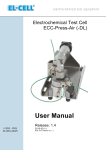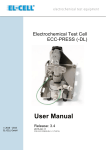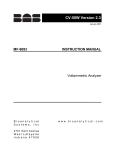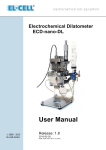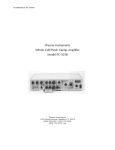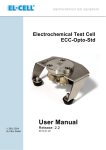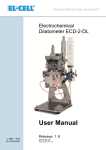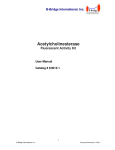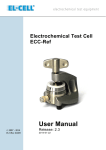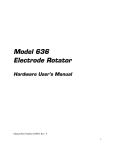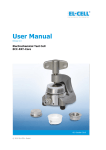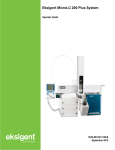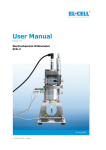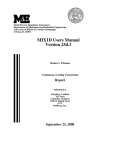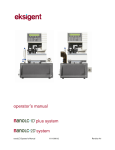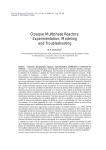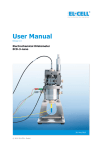Download User Manual - EL-CELL
Transcript
User Manual Release 1.8 2015-02-11 © 2010 – 2015 EL-CELL GmbH The information in this manual has been carefully checked and believed to be accurate; however, no responsibility is assumed for inaccuracies. EL-CELL GmbH maintains the right to make changes without further notice to products described in this manual to improve reliability, function, or design. ELCELL GmbH does not assume any liability arising from the use or application of this product. Content 1 Product Description ................................................................................................ 2 2 Features ................................................................................................................... 3 3 Safety Precautions ................................................................................................. 4 4 Unpacking ................................................................................................................ 4 5 Cell Assembly ......................................................................................................... 5 6 Operation Modes / Gas Supply ............................................................................ 8 7 Electrical Connection ............................................................................................. 9 8 Disassembly and Cleaning .................................................................................. 10 9 Accessories and Spare Parts.............................................................................. 11 10 Technical Support................................................................................................. 12 11 Warranty ................................................................................................................ 13 EL-CELL GmbH Tempowerkring 8 D-21079 Hamburg - Germany phone: +49 (0)40 790 12 734 fax: +49 (0)40 790 12 736 email: [email protected] web: www.el-cell.com -1- ECC_AIR_manual; 11/02/2015 1 Product Description The ECC-Air is another member of the modular ECC series dedicated to the electrochemical characterization of gas diffusion electrodes in aprotic electrolytes, in particular for lithium-air batteries. Basically, the cell accommodates the counter electrode (e.g. Li metal) on the cell bottom, a gas diffusion electrode on top, and a separator in between. The upper gas diffusion type electrode is contacted by, and “breathes” through the perforated stainless steel current collector on top. The cell lid is equipped with two ports for gas inlet and outlet, so that compressed gas can be passed through a siphon along the backside of the gas-diffusion electrode. The design includes a reference electrode located at the separator’s edge. Gold plated spring applies reproducible mechanical load on cell stack (10 … 50 N) Stainless steel lid with 2mm banana jacks SS 316L piston for corrosion resistance in aprotic media Cutting rings w/ PE seal ensure ultra-low leakage Inlet SS 316L base with 2mm Banana Jacks Outlet Stainless steel bracket makes assembly fast and easy PEEK sleeve ensures electrode concentricity and homogeneous current distribution ECC_AIR_manual; 11/02/2015 Siphon Cell stack Perforated plate -2- Reference electrode assembly 2 Features Test cell dedicated to the characterization of gas-diffusion electrodes in aprotic media. Upper electrode is contacted by, and breathes through a perforated current collector Gas inlet and outlet for supply of pressurized gases to the gas diffusion electrode A siphon directs the incoming gas to the backside of the gas diffusion electrode 3 Cell dead volume (head space) of approx. 4.3 cm High precision 18 mm diameter sandwich geometry with <0.1 mm electrode concentricity Reliable low leakage sealing with PE seal and PTFE ferrules Temperature operation range -20 to +70 °C Easy and reliable electrolyte filling upon assembly Fast assembly and dismantling, and easy cleaning of cell components Electrodes are easily accessible for post-mortem analysis Reusable cell components except for PE seal Small and defined electrolyte volume due to minimized dead volume Adjustable, reproducible and homogeneous mechanical pressure on electrodes -3- ECC_AIR_manual; 11/02/2015 Materials in media contact are stainless steel 1.4404 (SS 316L) and PEEK. Other materials available on request. Dedicated tools available to ease cell assembly and operation (http://el-cell.com/products/accessories-tools) Modular cell construction with many interchangeable components. Size (including bracket): 90 mm x 54 mm x 70 mm (height x width x depth). Weight: 640 g 3 Safety Precautions Use proper safety precautions when using hazardous electrode materials and electrolytes. Wear protective glasses and gloves to protect you against electrolyte that may accidentally spill out during filling and disassembly. Upon cell disassembly, dispose all materials properly. Metallic lithium and some insertion compounds may decompose heavily in contact with water and other solvents, and can cause fire. 4 Unpacking Check the contents of the packages against the list given below to verify that you have received all of the components. Contact the factory if anything is missing or damaged. NOTE: Damaged shipments must remain with the original packaging for freight company inspection. List of Components 1. Test cell with bracket, fully equipped for operation with and without reference 2. PE seals (10 pcs) 3. Glass fiber separator, 1.55 mm thick (10 pcs) ECC_AIR_manual; 11/02/2015 -4- 5 Cell Assembly In order to operate the test cell with a reference, the small feed-through hole of the REF sleeve is to be loaded with the reference material, usually metallic lithium. The vertical position of the reference is determined by the thickness of the components. Make sure that the electrodes and separator used have the appropriate thickness to avoid a Upper Electrode short circuit between the reference and anyone of the two other Separator electrodes. The smaller (inside) 0.9 mm diameter of the reference bore is 0.3 Lower Electrode mm. Assembly Steps: i) Make sure that the siphon is properly attached to the cell lid. For this purpose, plug the siphon into the cell lid with the siphon side bore pointing to the gas outlet port in the lid. Then attach the tube (transfer line) to the gas outlet port so that the tube end fits into the side bore and thus holds the siphon in place. ii) Pick up a small piece of lithium by a metal wire, and press the lithium into the feed-through hole of the REF sleeve until the lithium just arrives at the inner face of the sleeve. Note that significant force has to be applied to achieve that. A special REF loading tool is available for this purpose (not included). iii) Close the side opening of the cell base with the provided plug. This plug is later on replaced by the reference pin. iv) Assemble the two-part WE piston with the perforated current collector pointing upwards v) Insert the WE piston into the sleeve with the perforated current collector pointing upwards. -5- ECC_AIR_manual; 11/02/2015 vi) Put the 18 mm diameter gas diffusion electrode onto the piston inside the sleeve. vii) Put the glass fiber separator into the sleeve and dispense a defined amount of electrolyte onto it. The optimum amount of electrolyte depends on the electrodes and separator used, and has to be carefully 3 determined in pre-tests. 0.5 cm are a reasonable amount for 1.5 mm thick glass fiber separator. viii) Put the lithium CE disc (18 mm diameter, approx. 0.2 mm thick) on top of the cell stack. ix) Push the cell base over the assembly, hold the components tightly together, and turn the assembly back into the upright position. x) Release the pressure applied on the cell stack, mount the locking ring to align the side opening of the cell base with the feed-through hole of the REF sleeve, and replace the plug in the cell base by the spring-loaded REF pin. xi) Insert the PE seal and the spring. xii) Attach the cell lid with the siphon and tube already attached xiii) Push the cell into the bracket, and tighten the wing nut. xiv) Connect the inlet port to the gas supply, the outlet tube to the exhaust line. The provided fittings are compatible with 1/16 inch outer diameter tubing. We recommend the use of stainless steel or PEEKsil™ capillary tubing. NOTE: Consider using a floating mode potentiostat when grounding the cell lid through metal tubing. ECC_AIR_manual; 11/02/2015 -6- Wing Nut Siphon Lid with 2mm Banana Jacks Gas Inlet Gas Outlet Reference Assembly Gas Inlet Siphon Spring PE Washer (Seal) Locking Ring Gas Outlet Piston REF Sleeve Perforated Current Collector -7- ECC_AIR_manual; 11/02/2015 6 Operation Modes / Gas Supply Thanks to its modular design, the ECC-AIR test cell may be operated in different modes. Two basic set-ups are described below. A. Flow-through set-up This is the most typical configuration for the characterization of Li-air batteries. In the simplest set-up of this kind, the gas inlet is connected to the gas (oxygen) supply via a mass flow controller, and the pressure build-up inside the cell is controlled by means of a metering valve (or narrow capillary) connected to the gas outlet. For gas analysis, the gas outlet may be connected to the "continuous" gas flow inlet of a mass spectrometer. However, due to the cell’s considerable dead volume and backmixing the time-resolution of gas analysis is limited. Much better time resolution can be achieved with the ECC-DEMS test cell. B. Dead-end pressurized set-up In this configuration, the gas outlet is plugged, and the test cell is pressurized at the beginning of the experiment by means of an external gas supply connected to the gas inlet. After equilibration of the closed cell at constant temperature (the time constant being mainly determined by the slow dissolution of gases in the electrolyte), the cell is charged/ discharged and the resulting pressure change recorded. A gas sample port/ valve (P/N ECC1-00-0155-A) is available as an option. The sample port may be used to draw gas samples for subsequent analysis, or to pressurize the cell at the beginning of the experiment by means of a syringe. The ECC-PRESS-AIR is a version of the ECC-AIR featuring a pressure sensor and conditioning electronics to record the pressure evolution inside the cell. ECC_AIR_manual; 11/02/2015 -8- 7 Electrical Connection The electrical connection of the test cell to the potentiostat or battery tester is depicted below for 3-electrode operation (i.e. using a reference electrode). For 2-electrode operation the RE lead is to be connected to the cell base. Note that some potentiostats may not have the CE sense lead. WE Sense (Ref1) WE (WE/CA2) CE CE Sense (Ref3) (CE/CA1) RE (Ref2) The notations in brackets refer to the standard connection with a Biologic potentiostat (MPG-2, SP, VSP and VMP series). http://www.bio-logic.info/electrochemistry-ec-lab/instruments/ -9- ECC_AIR_manual; 11/02/2015 8 Disassembly and Cleaning Right after use, disassemble the cell in the reverse order of assembly. All chemicals used have to be disposed properly. Clean wetted parts with water and/or other appropriate solvent. Ultrasonic cleaning is recommended. Persistent dirt on the cell base and plunger may be removed by treatment with aqueous nitric acid (20%, 2 hours at room temperature). After cleaning, all parts are to be dried at 80°C in vacuum overnight. PE seal and PTFE ferrules are to be replaced. NOTE: Leaving cell parts in contact with ambient atmosphere while still being wetted with electrolyte may result in severe corrosion. ECC_AIR_manual; 11/02/2015 -10- 9 Accessories and Spare Parts ECC-Air Test Cell -11- ECC_AIR_manual; 11/02/2015 10 Technical Support Technical support for this product is exclusively handled by EL-Cell GmbH. The following procedure must be followed when the ECC test cell or any part of it is returned to EL-Cell GmbH for repair: 1. 2. 3. 4. 5. Send an e-mail to [email protected] to obtain a return authorization number and a decontamination report form. Sign the decontamination report asserting that the instrument has been decontaminated and is safe for technicians to work on it. Describe in detail what is wrong. Include a contact name, address, telephone number, and email address. Return the equipment to EL-Cell GmbH Tempowerkring 8 D-21079 Hamburg Germany Email [email protected] ECC_AIR_manual; 11/02/2015 -12- 11 Warranty For a period of one year from the date of shipment, EL-Cell GmbH (hereinafter Seller) warrants the goods to be free from defect in material and workmanship to the original purchaser. During the warranty period, Seller agrees to repair or replace defective and/or nonconforming goods or parts without charge for material or labour, or, at the Seller’s option, demand return of the goods and tender repayment of the price. Buyer’s exclusive remedy is repair or replacement of defective and nonconforming goods, or, at Seller’s option, the repayment of the price. Seller excludes and disclaims any liability for lost profits, personal injury, interruption of service, or for consequential incidental or special damages arising out of, resulting from, or relating in any manner to these goods. This Limited Warranty does not cover defects, damage, or nonconformity resulting from abuse, misuse, neglect, lack of reasonable care, modification, or the attachment of improper devices to the goods. This Limited Warranty does not cover expendable items. This warranty is void when repairs are performed by a non-authorized person or service centre. At Seller’s option, repairs or replacements will be made on site or at the factory. If repairs or replacements are to be made at the factory, Buyer shall return the goods prepaid and bear all the risks of loss until delivered to the factory. If Seller returns the goods, they will be delivered prepaid and Seller will bear all risks of loss until delivery to Buyer. Buyer and Seller agree that this Limited Warranty shall be governed by and construed in accordance with the laws of Germany. The warranties contained in this agreement are in lieu of all other warranties expressed or implied, including the warranties of merchantability and fitness for a particular purpose. This Limited Warranty supersedes all prior proposals or representations oral or written and constitutes the entire understanding regarding the warranties made by Seller to Buyer. This Limited Warranty may not be expanded or modified except in writing signed by the parties hereto. -13- ECC_AIR_manual; 11/02/2015














